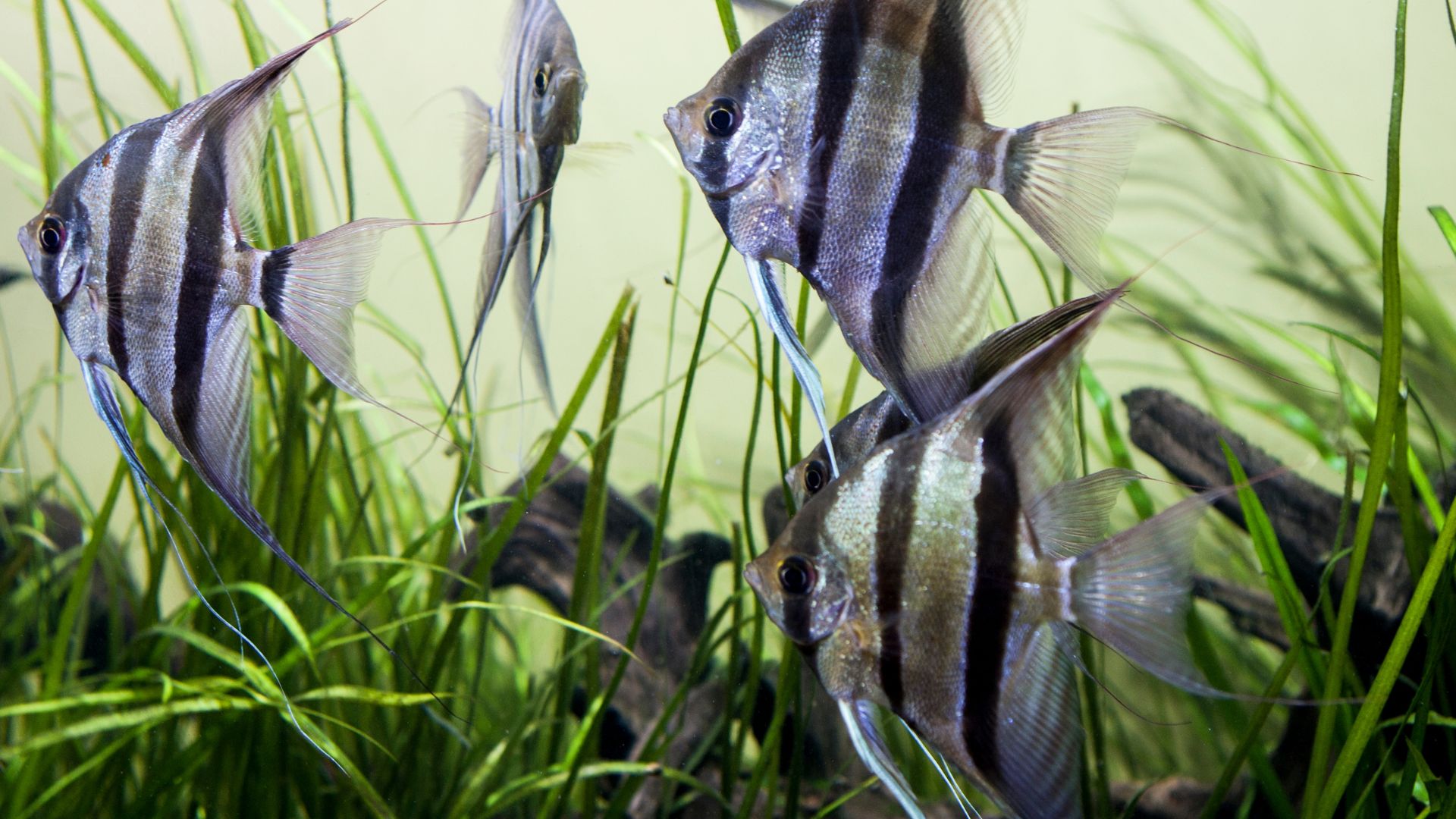
Angelfish
Scientific name: Pterophyllum scalare (common species), Pterophyllum altum, Pterophyllum leopoldi
The Angelfish is a popular and elegant freshwater fish native to the Amazon River basin in South America. Renowned for its tall, triangular shape and graceful swimming behavior, the Angelfish adds a touch of sophistication to any aquarium.
With a variety of color patterns and fin shapes available through selective breeding, they are a favorite among both novice and experienced aquarists.
IUCN Red List of Threatened Species : Not Evaluated
Angelfish prefer a well-planted aquarium that mimics their natural habitat, with plenty of vertical space to accommodate their tall fins. They thrive in slow-moving waters with hiding spots provided by driftwood, rocks, and broad-leafed plants. Maintaining stable water conditions is crucial, as they can be sensitive to poor water quality. While generally peaceful, they may exhibit territorial behavior, especially during breeding.
They are omnivorous and require a varied diet to maintain their health and vibrant colors. High-quality flake or pellet food should be supplemented with live or frozen foods like bloodworms, brine shrimp, and daphnia. Feeding should be monitored to prevent overfeeding and maintain water quality.

Navite Location
South America (Amazon River Basin in Brazil, Peru, Colombia, and surrounding regions)
Varieties
Silver / Marble / Veil / Koi / Black / Albino / Zebra
Suggested Tank Mates
Corydoras Catfish / Plecostomus (smaller species) / Dwarf Gouramis Larger Tetras (Black Skirt Tetras, Rummy Nose Tetras) / Rainbowfish / Bolivian Rams
Tank Mates to Avoid
Small fish that can be seen as food (Neon Tetras, small Rasboras) / Fin-nippers like Tiger Barbs / Aggressive or territorial fish / Bettas (potential for aggression)
Diet
High-quality flake or pellet food formulated for cichlids / Live or frozen foods (bloodworms, brine shrimp, daphnia) / Occasional vegetable matter (blanched spinach or peas) / Insect-based foods
Breeding
Angelfish are open breeders and form monogamous pairs. They prefer to lay their eggs on vertical surfaces like broad plant leaves, slate, or aquarium glass. Breeding requires optimal water conditions: slightly acidic to neutral pH and temperatures around 27°C to 30°C (80°F to 86°F).
Lifespan
Up to 10 years with proper care
Size
Up to 15 cm (6 inches) in length and height (excluding fins)
Minimum Tank Size
30 gallons (114 liters) for a small group; larger tanks are recommended due to their size and need for vertical space
Optimum Tank Temperature
24°C to 30°C (75°F to 86°F)
Ideal pH Level
6.0 to 7.5
Water Hardness
3 – 8 dGH (soft to moderately hard water)
Common Health Issues
Ich (White Spot Disease) / Fin Rot / Hole-in-the-Head Disease (Hexamitiasis) / Parasitic Infections / Stress-related illnesses due to poor water quality or inappropriate tank conditions
Interesting facts
Parental Care
Angelfish are attentive parents. Both male and female guard and care for the eggs and fry, cleaning them and protecting them from threats.
Selective Breeding
The wide variety of colors and fin types available in Angelfish is the result of extensive selective breeding by aquarists.
Cichlid Family
Angelfish belong to the cichlid family, which includes other intelligent and often territorial species.
Vertical Body Shape
Their tall, flat bodies are adapted for navigating through roots and vegetation in their natural flooded forest habitats.
Social Hierarchy
Angelfish can establish a pecking order within a group, which can influence feeding and behavior.
Angelfish FAQ’s
Can Angelfish Live in a Community Tank?
Yes, Angelfish can live in a community tank with compatible species. Ideal tank mates are similar-sized, peaceful fish that are not fin-nippers. Avoid keeping them with very small fish that could be seen as food or aggressive species that may harass them.
Do Angelfish Require a Tall Tank?
Due to their tall bodies and long fins, Angelfish appreciate tanks with greater height. A tank with a height of at least 50 cm (20 inches) is recommended to provide adequate swimming space.
How Can You Tell the Difference Between Male and Female Angelfish?
It can be challenging to distinguish between males and females. Subtle differences include the size and shape of the breeding tube (papilla) during spawning, with females having a larger, blunt papilla and males a smaller, pointed one.
Behavior during breeding is also a clue, but DNA testing is the only definitive method.
